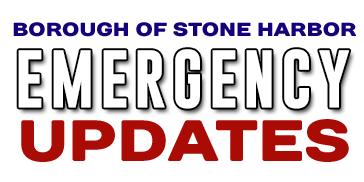Mitigation pays. It includes any activities that prevent an emergency, reduce the chance of an emergency happening, or lessen the damaging effects of unavoidable emergencies. Investing in mitigation steps now such as constructing barriers such as levees and purchasing flood insurance will help reduce the amount of structural damage to your home and financial loss from building and crop damage should a flood or flash flood occur.
BEFORE
- Use the Cape May County Flood Inundation Maps
- Find out if you live in a flood prone area from your Local Emergency Management office or opens in a new windowAmerican Red Crosschapter.
- Ask whether your property is above or below the flood stage water level and learn about the history of flooding for your region.
- Learn flood warning signs and your community alert signals.
- Request information on preparing for floods and flash floods.
- If you live in a frequently flooded area, stockpile emergency building materials. These include plywood, plastic sheeting, lumber nails, hammer and saw, pry bar, shovels, and sandbags.
- Have check valves installed in building sewer traps to prevent flood waters from backing up in sewer drains. As a last resort, use large corks or stoppers to plug showers, tubs, or basins.
- Plan and practice an evacuation route.
- Contact the Local Emergency Management office or local American Red Cross chapter for a copy of the community flood evacuation plan.
- This plan should include information on the safest routes to shelters. Individuals living in flash flood areas should have several alternative routes.
- Have disaster supplies on hand. (see emergency checklists for more info)
- Flashlights and extra batteries
- Portable, battery-operated radio and extra batteries
- First aid kit and manual
- Emergency food and water
- Non electric can opener
- Essential medicines
- Cash and credit cards
- Sturdy shoes
- Develop an emergency communication plan.
- In case family members are separated from one another during floods or flash floods (a real possibility during the day when adults are at work and children are at school), have a plan for getting back together.
- Ask an out-of-state relative or friend to serve as the “family contact.” After a disaster, it’s often easier to call long distance. Make sure everyone in the family knows the name, address, and phone number of the contact person.
- Make sure that all family members know how to respond after a flood or flash flood.
- Teach all family members how and when to turn off gas, electricity, and water.
- Teach children how and when to call 9-1-1, police, fire department, and which radio station to tune to for emergency information.
- Learn about the opens in a new windowNational Flood Insurance Program.
- Ask your insurance agent about flood insurance. Homeowners policies do not cover flood damage.
DURING A FLOOD WATCH
- Listen to a battery operated radio for the latest storm information.
- Fill bathtubs, sinks, and jugs with clean water in case water becomes contaminated.
- Bring outdoor belongings, such as patio furniture, indoors.
- Move valuable household possessions to the upper floors or to safe ground if time permits.
- If you are instructed to do so by local authorities, turn off all utilities at the main switch and close the main gas valve.
- Be prepared to evacuate.
DURING A FLOOD
If Indoors:
- Turn on battery-operated radio or television to get the latest emergency information.
- Get your preassembled emergency supplies.
- If told to leave, do so immediately.
If Outdoors:
- Climb to high ground and stay there.
- Avoid walking through any floodwaters. If it is moving swiftly, even water 6 inches deep can sweep you off your feet.
If In A Car:
- If you come to a flooded area, turn around and go another way.
- If your car stalls, abandon it immediately and climb to higher ground. Many deaths have resulted from attempts to move stalled vehicles.
DURING AN EVACUATION
- If advised to evacuate, do so immediately.
- Evacuation is much simpler and safer before flood waters become too deep for ordinary vehicles to drive through.
- Listen to a batter-operated radio for evacuation instructions.
- Follow recommended evacuation routes–shortcuts may be blocked.
- Leave early enough to avoid being marooned by flooded roads.
- Cape May County Evacuation Map

